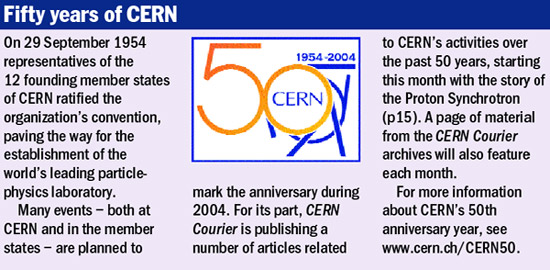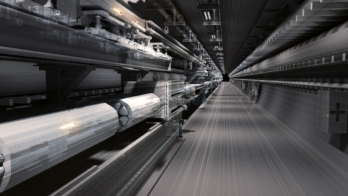
The CERN Council has formally approved the new structure for CERN, which was presented by the incoming director-general, Robert Aymar, at the Council’s meeting on 19 December 2003. The laboratory’s directorate will be composed of Aymar as chief executive officer, Jos Engelen as chief scientific officer and André Naudi as chief financial officer. CERN’s previous structure of 15 divisions will also be regrouped into a smaller number of departments. Aymar believes that the new structure, which will be implemented from 1 January 2004 for five years, “is well adapted to CERN’s current objectives. It ensures continuity and builds on existing strengths.”
Aymar comes to CERN from the ITER project, of which he was appointed director in July 1994, before becoming ITER’s international team leader in July 2001. He is familiar with the challenges presented by the Large Hadron Collider (LHC) – CERN’s most challenging project to date – as he chaired the international scientific committee that assessed and recommended the project for approval in 1996. He also chaired the External Review Committee that was set up by Council in December 2001 to review the CERN programme. In the new directorate he is joined by Engelen, formerly director of the Dutch National Institute for Nuclear Physics and High Energy Physics, NIKHEF, and Naudi, who was previously CERN’s director of finances.

Council was also presented with a review of the year’s activities by the outgoing director-general Luciano Maiani, who began with a comprehensive review of the LHC project. The experiments, ATLAS, CMS, ALICE and LHCb, are all on schedule to be ready for the start up of the LHC in 2007. Maiani pointed out that although challenges continue to be encountered, as is inevitable with such an ambitious scientific undertaking, the experimental collaborations are becoming adept at overcoming them. “Old concerns have been overcome, new ones have appeared,” Maiani concluded, “but there are no show-stoppers on the horizon.”
Turning to LHC computing, Maiani congratulated the international team that successfully launched phase 1 of the LHC Computing Grid (LCG-1) in September. The LCG team will be the first concrete example of an operational e-science Grid and a test bed for the Enabling Grids for e-science in Europe (EGEE) initiative, which is funded by the European Union and was launched in 2003.
The LHC machine itself passed a number of important milestones in 2003. The first octant of dipole magnets was completed, the first transfer-line magnet was installed on 17 December, and the first magnets for the LHC itself should be installed in the spring of 2004 (see“LHC dipole production begins to take off”).
“It has been a good year for the LHC project,” summed up Maiani. Overall, the project’s cost is stable and its schedule is unchanged, foreseeing first beam in April 2007 with the first collisions following in June.
In reviewing the rest of the year’s activities, Maiani reminded Council that the LHC project now accounts for more than 80% of the laboratory’s budget. Nevertheless, he described a full programme of fixed-target experiments, the highlight of which was the observation by the NA49 experiment of a new exotic particle, possibly a “pentaquark”.
In bidding farewell to the outgoing director-general at the end of his mandate, delegations from several member and observer states congratulated Maiani on steering CERN through a difficult period. He had, said one delegation, shown remarkable calm in a storm, and the laboratory’s staff had demonstrated the true strength and cohesion of the organization.
The new president of Council for 2004 was also elected at the meeting. Enzo Iarocci, who is currently president of the Italian National Institute for Research in Nuclear and Subnuclear Physics takes over from Maurice Bourquin of the University of Geneva. Best known for his development, in the late 1970s, of a new type of particle detector – the streamer tube – Iarocci was director of the Frascati Laboratories near Rome from 1990 to 1996, where he played an important role in the construction of the DAPHNE electron-positron storage ring.





